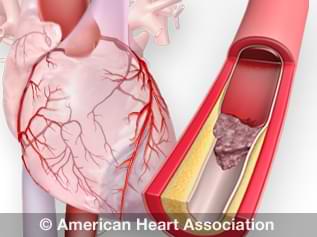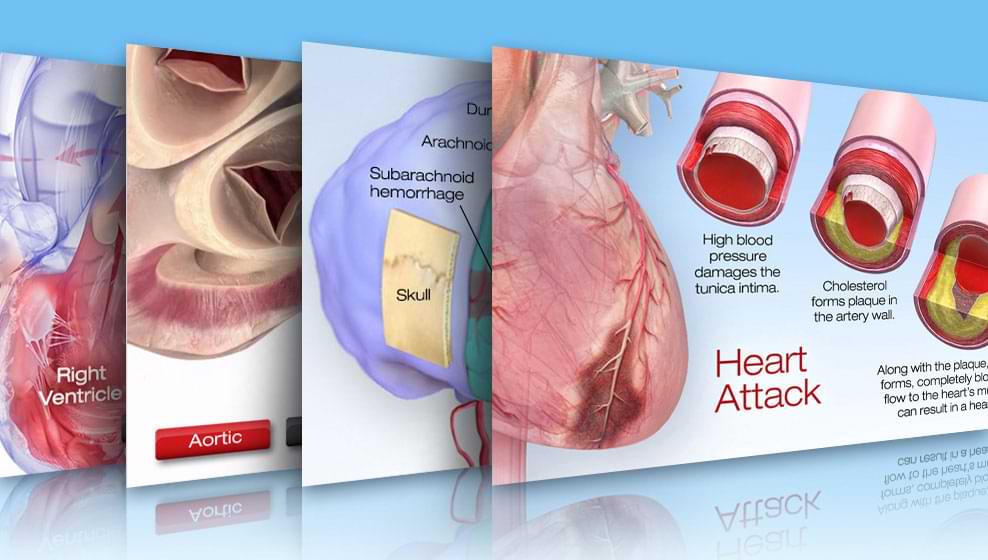What is a Heart Attack?
A heart attack is scary. If you’ve had one, or are close to someone who has, you’re not alone. Many people survive a heart attack and go on to enjoy productive lives.
As you work toward recovery, the frequently asked questions below can help you better understand what’s happened, and how your heart can heal. Knowledge is power. So use this information to live healthier and longer.
See how coronary artery damage leads to a heart attack.
Heart attack questions and answers
What is a heart attack?
Your heart muscle needs oxygen to survive. A heart attack occurs when the blood flow that brings oxygen to the heart muscle is severely reduced or cut off completely.
View an animation of blood flow between the heart and lungs.
This happens when coronary arteries that supply the heart muscle with blood flow become narrowed from a buildup of fat, cholesterol and other substances that together are called plaque. This slow process is known as atherosclerosis.
When plaque within a heart artery breaks, a blood clot forms around the plaque. This blood clot can block the blood flow through the artery to the heart muscle.
Ischemia is a condition in which the blood flow (and thus oxygen) is restricted or reduced in a part of the body. Cardiac ischemia is decreased blood flow and oxygen to the heart muscle. When damage or death to part of the heart muscle occurs due to ischemia, it’s called a heart attack, or myocardial infarction (MI).
About every 40 seconds, someone in the United States has a heart attack.
Why didn’t I have any warning?
The process of atherosclerosis may have no symptoms in its early stages. But when an artery is narrowed by over 70%, muscle pain or cramps may occur when tissue needs more oxygen than it’s able to receive.
When a coronary artery narrows and constricts blood flow, other nearby blood vessels that serve the heart sometimes expand to compensate, which may explain why there may be no warning signs.
Such a network of expanded nearby blood vessels is called collateral circulation, and it helps protect some people from heart attacks by delivering needed blood to the heart. Collateral circulation can also develop after a heart attack to help the heart muscle recover.
Is my heart permanently damaged?
When a heart attack occurs, the heart muscle that has lost blood supply begins to suffer injury. The amount of damage to the heart muscle depends on the size of the area supplied by the blocked artery and the time between injury and treatment.
Heart muscle damaged by a heart attack heals by forming scar tissue. It usually takes several weeks for your heart muscle to heal. The length of time depends on the extent of your injury and your rate of healing.
The heart is a tough organ. Even though part of it may have been severely injured, the rest of the heart keeps working. But, because of the damage, your heart may be weakened, and unable to pump as much blood as usual.
With proper treatment and lifestyle changes after a heart attack, further damage can be limited or prevented.
Learn more about heart damage detection.
How long will it take to recover from my heart attack?
Talk to your health care professional about your recovery time. Heart attacks can have longer or shorter recoveries and complications. It depends on the size and location of the damage and treatment of your heart attack.
In the damaged area, scar tissue may form and doesn’t contract or pump as well as healthy muscle tissue. As a result, the extent of damage to the heart muscle can affect how well the heart pumps blood throughout the body.
How much pumping function is lost depends on the size and location of the scar tissue. Most heart attack survivors have some degree of coronary artery disease (CAD) and will have to make important lifestyle changes and possibly take medication to prevent a future heart attack. Taking these steps can help you lead a full, productive life.
Learn more about recovering from heart attack.
Is all chest pain a heart attack?
No. But if you have chest pain or discomfort, see a health care professional right away. One common type of chest pain is called angina. It’s a recurring discomfort that usually lasts only a few minutes. Angina occurs when your heart muscle doesn’t get the blood supply and oxygen that it needs and is a signal that you’re at higher risk of having a heart attack.
The difference between angina and a heart attack is that angina attacks don’t permanently damage the heart muscle.
Different types of angina include:
- Stable angina, or angina pectoris. It often occurs during exercise or emotional stress when your heart rate and blood pressure increase, and your heart muscle needs more oxygen. Learn more about stable angina.
- Unstable angina. One of several acute coronary syndromes, it occurs while you’re resting or sleeping, or with little physical exertion. It comes as a surprise. Unstable angina can lead to a heart attack and it should be treated as an emergency. Learn more about unstable angina.
What are different medical terms for a heart attack?
Acute coronary syndrome (ACS): The umbrella term is for situations in which the blood supplied to the heart muscle is suddenly blocked. Learn more about ACS.
STEMI: A common name for ST-elevation myocardial infarction, it's caused by a complete blockage in a coronary artery.
NSTEMI: A non-ST-elevation myocardial infarction is when an artery is partially blocked and severely reduces blood flow.
Myocardial infarction (MI): It occurs when an area of the heart muscle (myocardium) is damaged or dies after blood supply is blocked. It’s the classic medical term for a heart attack.
Coronary thrombosis: It occurs when a clot is formed in one of the arteries that supply blood to the heart muscle. It's also called coronary occlusion.
Coronary occlusion: An obstruction of a coronary artery that hinders blood flow to some part of the heart muscle and can cause a heart attack.
Are there other causes of heart attack besides blockage?
Sometimes a coronary artery temporarily contracts or goes into spasm. When this happens, the artery narrows and blood flow to part of the heart muscle decreases or stops.
A spasm can occur in normal-appearing blood vessels as well as in vessels partly blocked by atherosclerosis. A severe spasm can cause a heart attack.
Another rare cause of heart attack is spontaneous coronary artery dissection (SCAD), which is a spontaneous tearing of the coronary artery wall.
How is a heart attack different from cardiac arrest?
People often use these terms to mean the same thing, but they describe different events.
A heart attack is when blood flow to the heart is blocked. It’s a circulation problem.
With sudden cardiac arrest (SCA), the heart malfunctions and suddenly stops beating. Sudden cardiac arrest is an electrical problem caused by irregular heart rhythms called arrhythmias. A common and potentially deadly arrhythmia is ventricular fibrillation. This happens when the heart’s lower chambers suddenly start beating chaotically and don’t pump blood.
A heart attack can cause ventricular fibrillation, which in turn can cause sudden cardiac arrest. Death can occur within minutes after the heart stops.
Cardiac arrest may be reversed if CPR (cardiopulmonary resuscitation) is performed and a defibrillator is used within minutes to shock the heart and restore a normal heart rhythm.
Learn more about the differences between heart attack and cardiac arrest.
You aren’t alone
Connect with other heart attack survivors and caregivers through our Support Network.
Learn more about diseases and conditions that affect your heart.
Heart Attack Tools and Resources
- What Are the Warning Signs of Heart Attack? (PDF)
- What is a Heart Attack? (PDF)
- How Will I Recover? (PDF)
- Heart Attack Discharge Worksheet (PDF)
- Heart Attack Discharge Worksheet (Spanish) (PDF)
- 5 Ways to Lower Your Risk of a Second Heart Attack (PDF)
- 5 Ways to Lower Your Risk of a Second Heart Attack - Spanish (PDF)
- Cardiac Rehab Referral Card (PDF)
- Cardiac Rehab Referral Card (Spanish) (PDF)
- Common Heart Attack Warning Signs (PDF)






